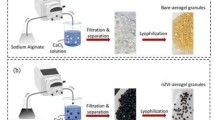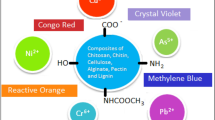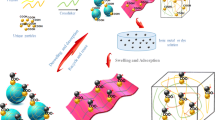Abstract
Stereoscopic porous microspheres based gellan gum (GG–Ca) were successfully prepared by sol–gel method using ethyl acetate as porogen and glutaraldehyde as crosslinker. The obtained GG–Ca microspheres were mainly of mesoporous with the average pore diameter was about 4 nm. It displayed a higher ability for uranium removal. In addition, the uranium adsorption process was endothermic and spontaneous following a pseudo-second-order and the adsorption isotherm was the best fit with the Freundlich model with maximum uranium capacity of 202.26 mg g−1. The UO2+ adsorption mechanism is ion-exchange with Ca2+ based on SEM, EDX and XPS data analysis.













Similar content being viewed by others
References
Cao J, Cohen A, Hansen J, Lester R, Peterson P, Xu H (2016) China–U.S. cooperation to advance nuclear power. Science 353:547–548
Monier M, Alatawy Raedah A, Abdel-Latif DA (2015) Synthesis and characterization of uranyl ion-imprinted microspheresbased on amidoximated modified alginate. Int J Biol Macromol 75:354–363
Li Y, Li L, Chen T, Duan T, Yao W, Zheng K, Dai L, Zhu W (2018) Bioassembly of fungal hypha/graphene oxide aerogel as high performanceadsorbents for U(VI) removal. Chem Eng J 347:407–414
Li B, Bai C, Zhang S, Zhao X, Li Y, Wang L, Ding K, Shu X, Ma L, Li S (2015) An adaptive supramolecular organic framework for highly efficient separation of uranium via in situ induced fit mechanism. J Mater Chem A 3:23788–23798
Wang Y, Liu Z, Li Y, Bai Z, Liu W, Wang Y, Xu X, Xiao C, Sheng D, Diwu J (2015) Umbellate distortions of the uranyl coordination environment result in a stable andporous polycatenated framework that can effectively remove cesium from aqueoussolutions. J Am Chem Soc 137:6144–6147
Bayramoglu G, Akbulut A, Ilkay Acıkgoz-Erkaya M, Arica Y (2018) Uranium sorption by native and nitrilotriacetate-modified Bangia atropurpurea biomass: kinetics and thermodynamics. J Appl Phycol 30:649–661
Zhou J, Zhu W, Yu J, Zhang H, Zhang Y, Lin X, Luo X (2018) Highly selective and efficient removal of fluoride from ground water by layered Al-Zr-La tri-metal hydroxide. Appl Surf Sci 435:920–927
Gulay Bayramoglu M, Arica Yakup (2016) MCM-41 silica particles grafted with polyacrylonitrile: modification into amidoxime and carboxyl groups for enhanced uranium removal from aqueous medium. Microporous Mesoprous Mater 226:117–124
Gulay Bayramoglu M, Arica Yakup (2017) Polyethylenimine and tris(2-aminoethyl)amine modified p(GMA-co-EGDMA) microbeads for adsorption of U(VI) ions: equilibrium, kinetic and thermodynamic studies. J Radioanal Nucl Chem 312:293–303
Liping W, Lin X, Zhou X, Luo X (2016) Removal of uranium and fluorine from wastewater by double-functional microsphere adsorbent of SA/CMC loaded with calcium and aluminum. Appl Surf Sci 384(30):466–479
Monier M, Abdel-Latif DA (2013) Synthesis and characterization of ion-imprinted resin based oncarboxymethyl cellulose for selective removal of UO2 2+. Carbohydr Polym 97:743–752
Yakup Arica M, Bayramoglua G (2016) Polyaniline coated magnetic carboxy-methylcellulose beads for selective removal of uranium ions from aqueous solution. J Radioanal Nucl Chem 310:711–724
Yi X, Sun F, Han Zhenhua, Han F, He J, Minrui O, Junjie G, Xiaoping X (2018) Graphene oxide encapsulated polyvinyl alcohol/sodium alginate hydrogel microspheres for Cu(II) and U(VI) removal. Ecotoxicol Environ Saf 158:309–318
Zhang Y, Lin X, Liu Hongyan, Qua Y, Luo X (2016) Preparation and characterization of a core–shell KNO3@alginate-Ca particle with uranium-removaland slow-release of KNO3. RSC Adv 6:112065–112078
Hamza M, Roux J-C, Guibal E (2018) Uranium and europium sorption on amidoxime-functionalized magneticchitosan micro-particles. Chem Eng J 344:124–137
Elsalamouny AR, Desouky OA, Mohamed SA, Galhoum AA, Guibal E (2017) Uranium and Neodymium biosorption using novel chelating polysaccharide. Int J Biol Macromol 104A:963–968
Sohbatzadeh H, Keshtkar AR, Safdari J, Yousefi T, Fatemi F (2017) Insights into the biosorption mechanisms of U(VI) by chitosan beadcontaining bacterial cells: a supplementary approach using desorptioneluents, chemical pretreatment and PIXE–RBS analyses. Chem Eng J 323:492–501
Zhou L, Shang C, Liu Z, Huang G, Adesina AA (2012) Selective adsorption of uranium(VI) from aqueous solutions using the ion-imprintedmagnetic chitosan resins. J Colloid Interface Sci 366:165–172
Yi X, He J, Guo Y, Han Z, Yang M, Jin J, Junjie G, Minrui O, Xiaoping X (2018) Encapsulating Fe3O4 into calcium alginate coated chitosan hydrochloride hydrogel beads for removal of Cu(II) and U(VI) from aqueous solutions. Ecotoxicol Environ Saf 147:699–707
Huang Z, Li Z, Zheng L, Zhou L, Chai Z, Wang X, Shi W (2017) Interaction mechanism of uranium(VI) with three-dimensional grapheneoxide-chitosan composite: insights from batch experiments, IR, XPS, andEXAFS spectroscopy. Chem Eng J 328:1066–1074
Pan D, Fan Q, Fan F, Tang Y, Zhang Y, Wangsuo W (2017) Removal of uranium contaminant from aqueous solution by chitosan@attapulgite composite. Sep Purif Technol 177:86–93
Elwakeel KZ, Atia Aa (2014) Uptake of U(VI) from aqueous media by magnetic Schiff’s base chitosan composite. J Clean Prod 70:292–302
Wang GH, Liu JS, Wang XG et al (2009) Adsorption of uranium(VI) from aqueous solution onto cross-linked chitosan. J Hazard Mater 168(2–3):1053
Sun SY, Wu LP, Lin XY et al (2017) Sorption of uranium(VI) by La-Al-carboxymethyl konjac glucomannan microsphere sorbent[J]. J Radioanal Nucl Chem 314(2):1039–1050
Yua J, Luo X, Liu B, Zhou J, Feng J, Zhu W, Wang S, Zhang Y, Lin X, Chen P (2018) Bayberry tannin immobilized bovine serum albumin nanospheres: characterization, irradiation stability and selective removal uranyl ion from radioactive wastewater. J Mater Chem A 6(31):1–11
Gulay Bayramoglu M, Arica Yakup (2016) Amidoxime functionalized Trametes trogii pellets for removal of uranium (VI) from aqueous medium. J Radioanal Nucl Chem 307(1):373–384
Prajapati VD, Jani GK, Zala BS, Khutliwala TA (2013) An insight into the emerging exopolysaccharide gellan gum as a novel polymer. Carbohydr Polym 93:670–678
Dhanka M, Shetty C, Srivastava R (2018) Methotrexate loaded gellan gum microparticles for drug delivery. Int J Biol Macro-mol 15:346–356
Osma T, Froelich A, Tasarek S (2014) Application of gellan gum in pharmacy and medicine. Int J Pharm 466:328–340
Dyondi D, Chandra V, Bhonde RR, Banerjee R (2012) Development and characterization of dual growth factor loaded in situ gelling biopolymeric system for tissue engineering applications. J Biomater Tissue Eng 2:1–9
Bellini D, Cencetti C, Meraner J, Stoppoloni D, Scotto A, Abusco D, Matricardi P (2015) An in situ gelling system for bone regeneration of osteochondral defects. Eur Polym J 72:642–650
Wang C, Gong Y, Lin Y, Shen J, Wang D (2008) A novel gellan gel-based microcarrier for anchorage-dependent cell delivery. Acta Biomater 4:1226–1234
Chakraborty S, Jana S, Gandhi A, Kumar K, Zhiang W, Kokare C (2014) Gellan gum microspheres containing a novel alpha-amylase from marine Nocardiopsis sp. strain B2 for immobilization. Int J Biol Macromol 70:292–299
Rosas-flores W, Ramos-ramírez EG, Salazar-montoya JA (2013) Microencapsulation of Lactobacillus helveticus and Lactobacillus delbrueckii using alginate and gellan gum. Carbohydr Polym 98:1011–1017
Karthika JS, Vishalakshi B (2015) Novel stimuli-responsive gellan gum-graft- poly(DMAEMA) hydrogel as adsorbent for anionic dye. Int J Biol Macromol 81:648–655
Verma SK, Pandey VS, Behari Kunj MY (2015) Gellan gum-g-N-vinyl-2- pyrrolidone: synthesis, swelling, metal ion uptake and flocculation behavior. Int J Biol Macromol 72:1292–1300
Lazaro Nuria, Sevilla Asuncion Lopez, Morales Susana, Marques Ana M (2003) Heavy metal biosorption by gellan gum gel beads. Water Res 37:2118–2126
Nussinovitch A, Dagan O (2015) Hydrocolloid liquid-core capsules for the removal of heavy-metalcations from water. J Hazard Mater 299:122–131
Yuan Y, Yang Y, Faheem M, Zou X, Ma X, Wang Z, Meng Q, Wang L, Zhao S, Zhu G (2018) Molecularly imprinted porous aromatic frameworks and their composite components for selective extraction of uranium ions. Adv Mater. https://doi.org/10.1002/adma.201706507
Eskandarloo H, Godec M, Arshadi M, Padilla-Zakour OI, Abbaspourrad A (2018) Multi-porous quaternized chitosan/polystyrene microbeads for scalable, efficient heparin recovery. Chem Eng J 348:399–408
Monier M, Elsayed NH (2014) Selective extraction of uranyl ions using ion-imprinted chelatingmicrospheres. J Colloid Interface Sci 423:113–122
Langmuir I (1918) The adsorption of gases on plane surfaces of glass, mica and platinum. J Am Chem Soc 40:361–1368
Freundlich HMF (1906) Over the adsorption in solution. J Phys Chem 57:385–471
Mittal A, Kurup L, Mittal J (2007) Freundlich and Langmuir adsorption isotherms and kinetics for the removal of Tartrazine from aqueous solutions using hen feathers. J Hazard Mater 146(1):243–248
Ai L, Luo X, Lin X et al (2013) Biosorption behaviors of uranium (VI) from aqueous solution by sunflower straw and insights of binding mechanism. J Radioanal Nucl Chem 298(3):1823–1834
Al-Masri MS, Amin Y, Al-Akel B et al (2010) Biosorption of cadmium, lead, and uranium by powder of poplar leaves and branches. Appl Biochem Biotechnol 160(4):976–987
Acknowledgements
This research was financially supported by the Science and Technology Support Plan of Qinghai Province (2015-SF-119) and Longshan Academic talent Research Support Plan of Southwest University of Science and Technology (17LZX302). The authors gratefully acknowledged the technology support of Engineering Research Center for Biomass Materials, Ministry of Education, Southwest University of Science and Technology.
Author information
Authors and Affiliations
Corresponding author
Rights and permissions
About this article
Cite this article
Liang, L., Lin, X., Sun, S. et al. Stereoscopic porous gellan gum-based microspheres as high performance adsorbents for U(VI) removal. J Radioanal Nucl Chem 319, 213–225 (2019). https://doi.org/10.1007/s10967-018-6323-1
Received:
Published:
Issue Date:
DOI: https://doi.org/10.1007/s10967-018-6323-1




